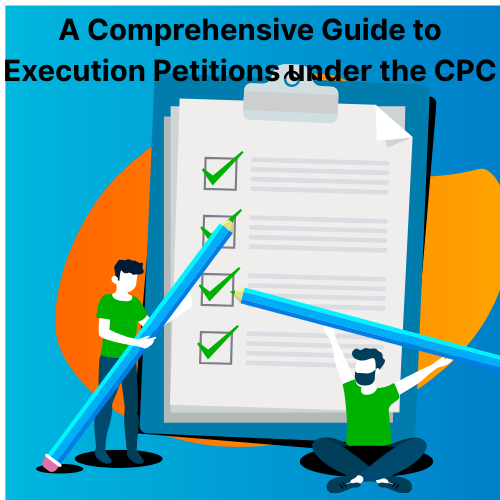📌 Introduction
Winning a case in court is only half the battle. The real challenge begins when a party has to enforce the judgment. This is where an Execution Petition under the Civil Procedure Code (CPC), 1908 comes into play.
An execution petition is filed when the decree-holder wants to enforce the judgment and recover compensation from the judgment-debtor. However, the process can be time-consuming and complex, requiring a deep understanding of legal procedures.
This blog provides a detailed guide on execution petitions, covering:
✅ What is an Execution Petition?
✅ Legal framework under CPC
✅ Types of execution methods
✅ Common challenges & solutions
✅ Real-life case studies
Additionally, we’ll explore how Handyy Law Practice Management Software helps advocates streamline petition filing, track court proceedings, and automate case management.
📜 What is an Execution Petition Under CPC?
An Execution Petition is a legal request filed by the decree-holder in court to enforce the judgment and ensure the judgment-debtor complies with the decree.
🔹 Key Provisions Under CPC
✔️ Section 36 to 74: Provides the legal foundation for execution petitions.
✔️ Order 21 of CPC: Lays down detailed procedures for enforcing decrees and orders.
Once the petition is filed, the court takes necessary actions, such as:
📌 Issuing notices to the judgment-debtor
📌 Attachment of properties/assets
📌 Appointing a receiver for property
📌 Issuing a warrant for arrest (in certain cases)
📌 How Handyy Helps:
✅ Automates petition drafting with ready-made legal templates.
✅ Tracks case status and court orders with real-time updates.
⚖️ Types of Execution Methods Under CPC
There are various methods available for executing a decree under Order 21 of CPC:
1️⃣ Execution by Attachment and Sale of Property (Order 21, Rules 41-54)
If the judgment-debtor refuses to comply, the decree-holder can request the court to attach and sell movable or immovable properties.
✔️ Example Case: In XYZ Bank vs. Arvind Kumar (2023), the court ordered the attachment of the debtor’s property when he failed to pay a bank loan.
📌 How Handyy Helps:
✅ Maintain case history and property records digitally.
✅ Generate notices and legal documents instantly.
2️⃣ Execution by Arrest and Detention (Order 21, Rules 37-40)
If the judgment-debtor deliberately avoids compliance, the court may order arrest and detention in civil prison.
✔️ Example Case: In Mohan vs. Rajiv (2022), the court issued an arrest warrant for the debtor who refused to settle dues despite multiple court orders.
📌 How Handyy Helps:
✅ Manage case updates and legal notices efficiently.
✅ Access judgment history and prepare legal responses quickly.
3️⃣ Execution by Garnishee Order (Order 21, Rule 46)
A garnishee order allows the decree-holder to recover money directly from third parties who owe money to the judgment-debtor (e.g., bank accounts).
✔️ Example Case: In ABC Pvt Ltd vs. XYZ Enterprises (2023), the court directed XYZ’s bank to release funds directly to ABC Pvt Ltd.
📌 How Handyy Helps:
✅ Monitor case progress and maintain financial records seamlessly.
4️⃣ Execution by Appointment of Receiver (Order 21, Rule 49-50)
A receiver is appointed to take control of the debtor’s business or assets and ensure compliance with the decree.
✔️ Example Case: In Sharma vs. Gupta (2021), the court appointed a receiver to manage the judgment-debtor’s rental properties and divert income toward the decree-holder.
📌 How Handyy Helps:
✅ Store case files and court orders securely in the cloud.
🚀 Common Challenges in Execution Petitions & Solutions
| Challenges | Solutions |
|---|---|
| Judgment-debtor refusing compliance | Request attachment or arrest orders under CPC |
| Delays in court proceedings | File urgent applications for faster execution |
| Missing legal documents | Use Handyy’s document management system |
| Difficulty tracking multiple cases | Use Handyy’s case tracking tools |
📚 Case Study: Successful Execution Petition
Case: ABC Corporation vs. Sunil Kumar (2023)
✔️ Issue: ABC Corporation won a commercial dispute, but Sunil Kumar refused to pay ₹50 lakh compensation.
✔️ Legal Action: ABC filed an execution petition, requesting attachment of Kumar’s factory property.
✔️ Court Ruling: The court issued an attachment order, and the property was auctioned to recover dues.
📌 Outcome: The decree was successfully executed, and ABC received the full compensation.
🔎 How Handyy Simplifies Execution Petitions for Advocates
✔️ Pre-Built Legal Templates: Generate execution petitions, notices, and affidavits instantly.
✔️ Automated Case Management: Track case status and receive real-time court updates.
✔️ Cloud-Based Secure Storage: Store all case files, judgments, and decrees securely.
✔️ AI-Based Legal Assistance: Get case analysis and next-step suggestions for execution petitions.
✔️ Effortless Client Communication: Send automated case updates and notices via WhatsApp & email.
📌 No more manual paperwork! Handyy Law Practice Management Software automates execution petition processes—saving you time and effort.
🛠️ FAQ on Execution Petition Under CPC
1️⃣ Who can file an execution petition?
👉 The decree-holder or their legal representative.
2️⃣ Which court has jurisdiction?
👉 The court that passed the decree or the court where the judgment-debtor resides.
3️⃣ Can an execution petition be challenged?
👉 Yes, the judgment-debtor can file objections under Order 21, Rule 58 CPC.
4️⃣ What is the limitation period for filing execution petitions?
👉 Generally, 12 years from the date of decree under Article 136 of the Limitation Act, 1963.
5️⃣ How does Handyy assist in filing execution petitions?
👉 Automates drafting, tracks case updates, and stores documents securely.
📌 Final Call to Action
Don’t let execution delays affect your clients’ justice!
✅ Sign up for Handyy’s 30-day FREE TRIAL today! 🚀

